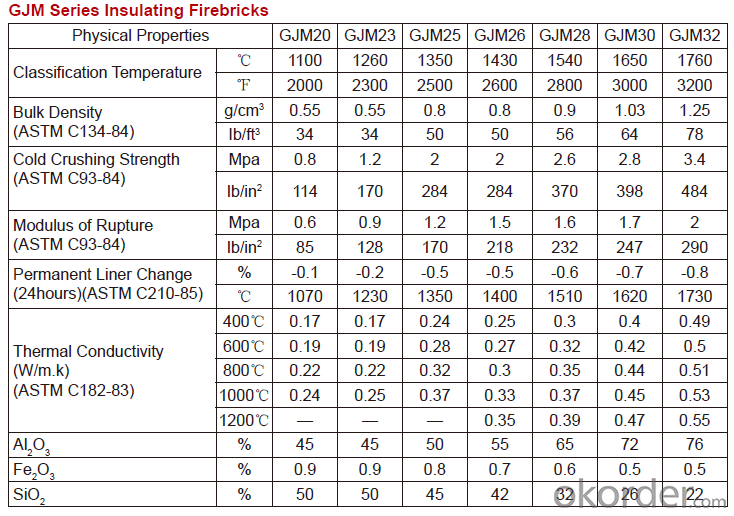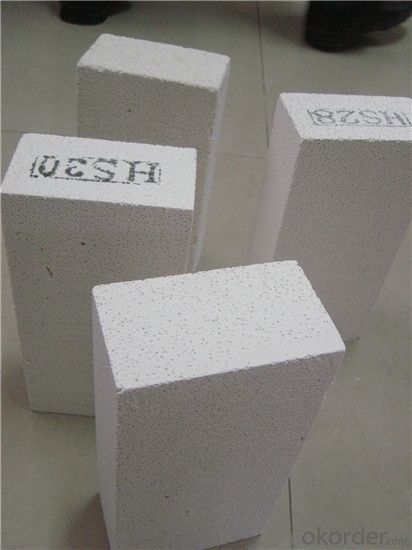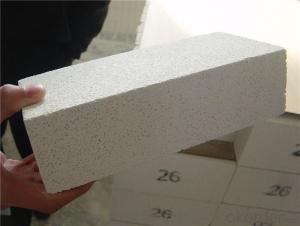GJM 28 Light Dense Mullite Insulation Brick Produc
- Loading Port:
- Shanghai
- Payment Terms:
- TT OR LC
- Min Order Qty:
- 1 m.t.
- Supply Capability:
- 10000 m.t./month
OKorder Service Pledge
OKorder Financial Service
You Might Also Like
Thermal Insulation Fire Clay Brick
Refractory brick is a refractory material used in lining furnaces, kilns, fireboxes, and fireplaces.
We provide high quality Refractory Fire Bricks that are used on wide range in the various industries like Cement, Glass and Steel. Refractory Fire Bricks are provided as per the quantity and specifications required by the customers. We provide an extensive range of Refractory Fire Bricks at reasonable prices that depend upon the quantity ordered.
Application
Insulating Fire Brick are used for the lining of converter, alternating current arc furnace, direct Current arc furnace and the ladle slag line, etc.
Company Advantage
(1)Long Insulating Fire Brick manufacture history: 25 years manufacturer
(2)Advanced equipment and good service
(3)Diversification of production standards: ISO ANSI FEPA JIS ASTM
(4)Flexible payment: T/T L/C D/P D/A
(5)Professional marketing team and after-sale service
Insulating Fire Brick main feature:

Equipment
1 unit of Ceramic Abrasive (SG Abrasive) pilot production line
2 units of Compact grain Abrasive pilot production lines
1 unit of high-end coated abrasives (abrasive cloth) production line
3 large flexible crushing and sieving lines for grit production lines
6 units of 5000KVA-10000KVA dumping type electric arc furnaces for Brown Fused Alumina fusion
FAQs
Q1 What’s the transport method?
A1 FCL delivery goods with wooden pallet or wooden case by sea; If LCL delivery, must with wooden case; Sometimes need open top, flat rack or bulk cargo.
Q2 What’s the required payment term?
A2 Generally 30% TT as the prepayment, 70% TT before delivery. If need, 100% Irrevocable Letter of Credit or negotiation.
Q3 Which country are our products exported to?
A3 Apart from entire Chinese market, the US, Russia, Japan, Korea, Australia and some Southeast Asian Nations.


- Q:Are insulating fire bricks resistant to high-velocity gas flow erosion?
- Yes, insulating fire bricks are generally resistant to high-velocity gas flow erosion. These bricks are designed to withstand high temperatures and are made from materials that can withstand the erosive effects of gases flowing at high velocities. However, the resistance may vary depending on the specific composition and quality of the fire bricks.
- Q:Can insulating fire bricks be used for insulation in heat recovery systems?
- Yes, insulating fire bricks can be used for insulation in heat recovery systems. Insulating fire bricks are specifically designed to withstand high temperatures and provide effective thermal insulation. They have low thermal conductivity, which means they can minimize heat loss and maximize heat recovery in a system. These bricks are often used in various industrial applications such as kilns, furnaces, and ovens, where temperature control and energy efficiency are important. Therefore, they can be a suitable choice for insulating heat recovery systems, helping to optimize the recovery and utilization of waste heat.
- Q:Can insulating fire bricks be used in chimneys or flues?
- It is not advisable to use insulating fire bricks directly in chimneys or flues due to their primary purpose of insulation rather than being a structural component. Chimneys and flues require refractory bricks that are specifically engineered to withstand the intense heat and corrosive byproducts of combustion. These refractory bricks have high thermal resistance and exceptional durability, ensuring the safe and efficient operation of the chimney or flue. Therefore, it is recommended to use refractory bricks instead of insulating fire bricks for construction or repair purposes in chimneys and flues.
- Q:Can insulating fire bricks be used for fireplace lining?
- Yes, insulating fire bricks can be used for fireplace lining. Insulating fire bricks are specifically designed to withstand high temperatures and provide excellent insulation. They have a low thermal conductivity, which means they can effectively retain heat and prevent excessive heat loss from the fireplace. This makes them an ideal choice for lining fireplaces as they help to increase the efficiency and effectiveness of the heating system. Additionally, insulating fire bricks are also resistant to thermal shock and can withstand rapid temperature changes, which is important in a fireplace where the temperature can fluctuate significantly. Overall, using insulating fire bricks for fireplace lining can improve the performance and energy efficiency of the fireplace while ensuring safety and durability.
- Q:Are insulating fire bricks resistant to thermal bridging?
- Yes, insulating fire bricks are resistant to thermal bridging. These bricks are designed to minimize heat transfer by reducing thermal conductivity, making them an effective solution for preventing thermal bridging in various applications.
- Q:Can insulating fire bricks be used in the construction of tundishes?
- Yes, insulating fire bricks can be used in the construction of tundishes. Insulating fire bricks are lightweight and have excellent thermal insulation properties, making them ideal for applications where heat retention is important. Tundishes, which are used in the steel industry to control the flow of molten metal, require materials that can withstand high temperatures and minimize heat loss. Insulating fire bricks can withstand the extreme temperatures found in tundishes, helping to maintain the desired temperature of the molten metal and preventing heat loss. Additionally, their lightweight nature makes them easier to handle and install in tundish construction. Overall, insulating fire bricks are a suitable choice for the construction of tundishes due to their thermal insulation properties and ability to withstand high temperatures.
- Q:Do insulating fire bricks require any special fireproof gaskets or seals?
- Special fireproof gaskets or seals are not necessary for insulating fire bricks. These bricks are specifically made to withstand high temperatures and have a strong resistance to heat, eliminating the need for any extra gaskets or seals. They are commonly used in kilns, furnaces, and fireplaces to provide insulation and retain heat. Their composition and structure create a barrier against heat transfer, eliminating the necessity of additional seals or gaskets. Nevertheless, it is crucial to install and align the bricks correctly to ensure a secure fit and optimize their insulating capabilities.
- Q:Are insulating fire bricks suitable for use in chimneys and fireplaces?
- Yes, insulating fire bricks are suitable for use in chimneys and fireplaces. They have excellent thermal insulation properties, which helps to retain heat and prevent the transfer of excessive heat to the surrounding structure. This makes them a safe and efficient choice for lining chimneys and fireplaces, as they can withstand high temperatures and reduce the risk of heat damage.
- Q:Can insulating fire bricks be used in the construction of ceramic fiber kilns?
- Yes, insulating fire bricks can be used in the construction of ceramic fiber kilns. Insulating fire bricks are designed to provide thermal insulation and reduce heat loss in high-temperature applications. They have excellent insulating properties, with low thermal conductivity, which makes them ideal for use in kilns where high temperatures need to be maintained. By using insulating fire bricks in the construction of ceramic fiber kilns, it is possible to enhance the overall energy efficiency of the kiln and improve its performance. However, it is important to ensure that the insulating fire bricks are compatible with the specific requirements and operating conditions of the ceramic fiber kiln to ensure optimal results.
- Q:What is mullite insulation brick?
- Mullite brick, according to different density can be divided into: lightweight mullite brick and heavy mullite brick;
1. Manufacturer Overview |
|
|---|---|
| Location | |
| Year Established | |
| Annual Output Value | |
| Main Markets | |
| Company Certifications | |
2. Manufacturer Certificates |
|
|---|---|
| a) Certification Name | |
| Range | |
| Reference | |
| Validity Period | |
3. Manufacturer Capability |
|
|---|---|
| a)Trade Capacity | |
| Nearest Port | |
| Export Percentage | |
| No.of Employees in Trade Department | |
| Language Spoken: | |
| b)Factory Information | |
| Factory Size: | |
| No. of Production Lines | |
| Contract Manufacturing | |
| Product Price Range | |
Send your message to us
GJM 28 Light Dense Mullite Insulation Brick Produc
- Loading Port:
- Shanghai
- Payment Terms:
- TT OR LC
- Min Order Qty:
- 1 m.t.
- Supply Capability:
- 10000 m.t./month
OKorder Service Pledge
OKorder Financial Service
Similar products
New products
Hot products
Related keywords



























